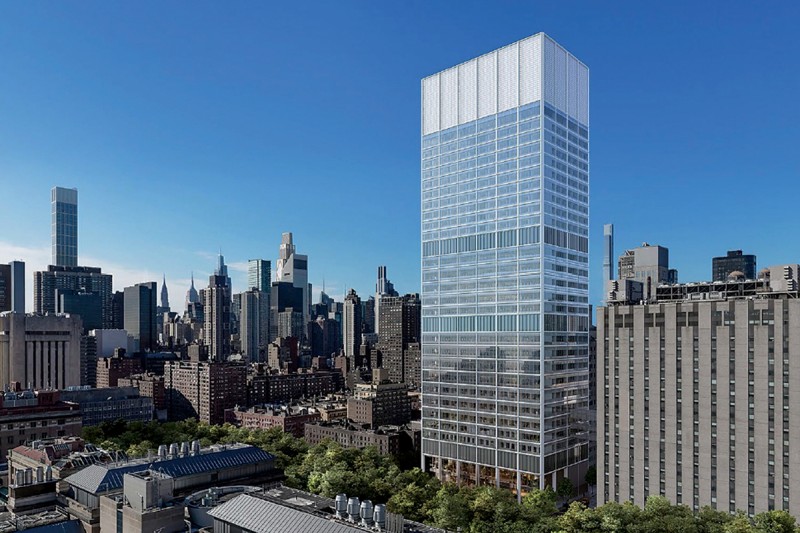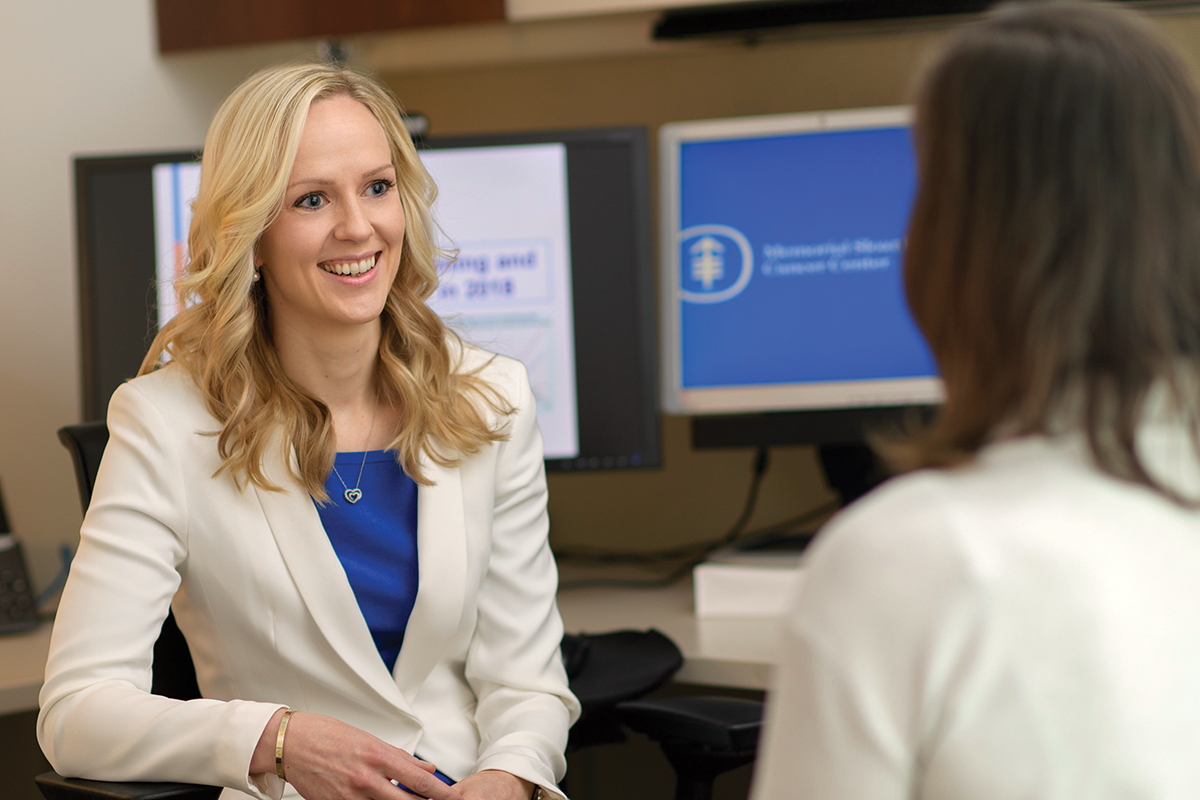
The MSK Pavilion, scheduled to open in 2030, will provide the additional space and advanced technology needed for the dramatic increase in cancer cases in the coming decades.
The prognosis is sobering.
“There is a coming surge of cancer cases, on top of the storm that is already upon us,” says Jeffrey Drebin, MD, PhD, Chair of Surgery at Memorial Sloan Kettering Cancer Center (MSK).
According to the Centers for Disease Control and Prevention, the number of people with cancer will increase by 50% by 2050, with more than 60,000 new cases each year in New York City alone.
Why are cancer rates increasing? America is aging; some call it the silver tsunami. At the same time, more people are being diagnosed at a younger age with colon, prostate, and breast cancers. And ironically, successful therapies create a new set of concerns for the future.
“Thanks to advances in cancer treatment, patients will be living longer, and their needs will change as we continue to care for them,” says Lisa DeAngelis, MD, Chief Physician Executive at MSK. “Not only will more people have the disease, but their care also will become more specialized as they grow older. And the increasing number of younger patients will need support for a lifetime.”
How MSK Is Creating the Cancer Center of the Future in NYC
MSK is getting ready for the future demand for cancer care now with plans underway to construct a 900,000-square-foot facility connected via a patient bridge to the current hospital at 1275 York Avenue, which is more than 50 years old and already operating at capacity.
The new MSK Pavilion will provide the additional space and advanced technology necessary to keep pace with the evolving needs of cancer patients, ensuring high-quality care for generations to come.
Devoted entirely to acute patient care, the building will house state-of-the-art operating suites and more than 200 private patient rooms, including 40 beds in intensive care. It’s scheduled to open in 2030.
“The MSK Pavilion is the cancer hospital of tomorrow,” says Marcia Levine, MSN, RN, Vice President of Perioperative and Inpatient Nursing Services, who has been deeply involved in the Pavilion planning. “The building is being designed in close consultation with MSK doctors and nurses to deliver the care they want their patients to have. That priority is driving every decision.”
This trailblazing facility will improve the cancer patient experience in ways both large and small. For example:
- New technology will improve surgery and imaging, as well as care coordination essential for complex cases.
- The latest clinical techniques will minimize pain and nausea.
- The hospital atmosphere will welcome patients and caregivers with calming landscaping as they enter, a thoughtful patient drop-off area and parking system, abundant natural lighting, and private rooms.
MSK’s Experience Will Drive Future Innovation
The coming Pavilion is not the only way MSK is preparing for the future and innovating right now. MSK is also looking to its past.

Epidemiologist Dr. Sigrid Carlsson is focused on ways to improve a patient’s experience in the hospital and after they are discharged.
There are many lessons learned from the Josie Robertson Surgery Center (JRSC), which opened in 2016. Doctors perform more than 10,000 operations a year at JRSC, which specializes in outpatient and short-stay surgical procedures. According to urologic surgeon Vincent Laudone, MD, Chief of Surgery at JRSC, MSK researchers have published findings of more than 50 studies performed at JRSC and always have a dozen or more ongoing projects.
“In addition to serving patients,” says Dr. Laudone, “JRSC has enabled us to do a great deal of research into ways to improve care.” He adds, “The large number of people we treat and our ability to collect detailed information on the outcomes of every patient allows us to get answers quickly and put them into practice.”
New Ways to Improve Pain Relief and Reduce Opioids for Cancer Patients
“Effective pain and nausea management are crucial for facilitating a smooth transition from hospital care to home recovery, as they can be a major barrier to discharge especially in a busy ambulatory center,” says MSK anesthesiologist Anoushka Afonso, MD, Director of MSK’s Enhanced Recovery Programs, Anesthesia & Critical Care Medicine.
In recent years, MSK has developed new approaches for painkillers to reduce dependence on opioids. Researchers are also studying the best way to give nerve blocks to breast cancer patients undergoing a double mastectomy and breast reconstruction.
“There are many ways to do nerve blocks — from the front or back, and above or below certain muscles — and our research can give us a definitive answer as to which works best,” says Hanae K. Tokita, MD, Director of Anesthesia at JRSC, who is leading the trial with 1,500 participants — an unprecedented size for a single institution. “It provides the kind of top-level evidence that could change clinical practice.”
How MSK Is Making the Hospital More Hospitable
No one enjoys being in the hospital. The jarring sounds and harsh lighting can add to an already stressful experience.
“We’re always focused on finding ways to minimize the anxiety people normally feel in a hospital,” says epidemiologist Sigrid Carlsson, MD, PhD, MPH, JRSC’s Director of Clinical Research.
Promoting Peace and Quiet in the Hospital
Seeking creative solutions for the future, MSK has tapped into health technology companies. One study is looking into masking disruptive hospital noises with “reactive soundscaping” to create a calm oasis for patients. Certain rooms at JRSC are now outfitted with standard white noise, while others receive gentle nature sounds — such as wind, rain, or waves — that react and adjust to sounds of the room in real time.
“We know noise is a big issue in hospitals, causing stress, interrupted sleep, and confusion for patients,” says Christopher Brause, the Clinical Experience Design Lead on MSK’s Informatics team. “We hope to improve how people feel. We also will look to see if there are more measurable benefits — better vital signs, improved sleep, faster discharge, or less need for pain medication.”
Letting Patients Get More Sleep
Nurse leader Blanca Vasquez Clarfield, PhD, hospitalist Barbara C. Egan, MD, and other medical staff have driven another approach to promote better rest at Memorial Hospital. For patients who are medically stable and alert, no vital signs are taken between and , and early-morning blood draws are postponed until later.
Using New Technology to Improve At-Home Care and Recovery
But no matter how hospitable a hospital environment may be, patients want to go home as soon as possible.
And when patients are discharged, they will take the hospital home with them, using new tools to keep close watch over their well-being.
The MSK Pavilion will implement practices developed at JRSC to bring the hospital home. At JRSC, patients wear devices so their activity can be closely watched to make sure they are recovering on schedule. And when they go home, MSK care teams continue to monitor them with Recovery Tracker, an electronic survey system that allows them to report symptoms such as pain, nausea, or fatigue for the first 10 days after discharge.
“This system reassures patients that even though they’ve walked out of the doors of the hospital, they haven’t left MSK,” Dr. Carlsson says. “It goes a long way toward easing anxiety.”
It also reduces the odds that patients will need urgent care by 42%, according to a study led by Dr. Laudone and reported in JAMA Surgery.
“Because we take extreme care when patients are in the hospital and when they go home, we continue to have very low rates of readmission,” Dr. Laudone says.
Transforming the Cancer Patient Journey
Dr. DeAngelis notes these are just a few examples of how MSK is building a bold new infrastructure that is centered on the patient and expands MSK’s reach into communities to improve access to world-class cancer care. “No matter the coming surge in cases, we will be ready,” Dr. DeAngelis says. “We will continue to achieve the best possible outcomes for our patients, with compassion and our collective determination to support their very best quality of life.”
Dr. DeAngelis holds the Scott M. and Lisa G. Stuart Chair.
Dr. Drebin holds the Murray F. Brennan Chair in Surgery.


